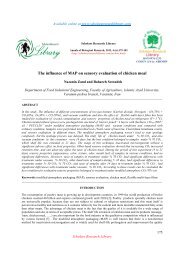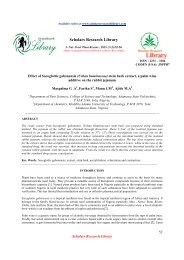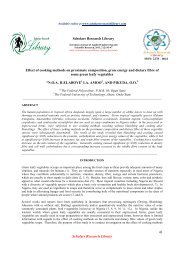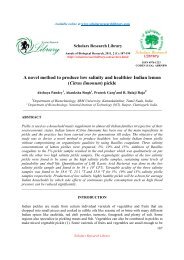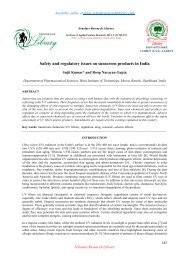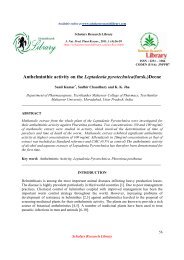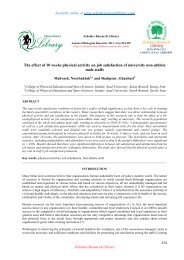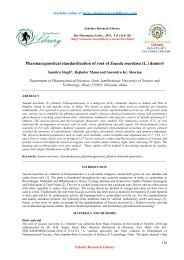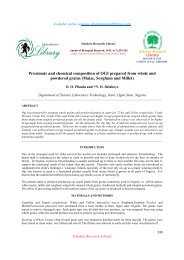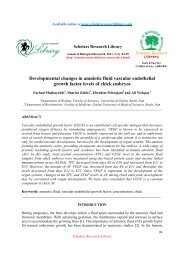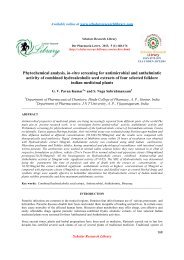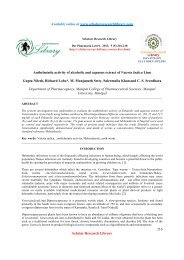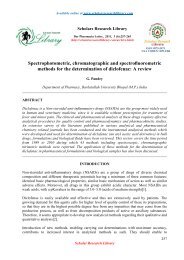Anthelmintic activity of Cassia auriculata L. extracts-In vitro study
Anthelmintic activity of Cassia auriculata L. extracts-In vitro study
Anthelmintic activity of Cassia auriculata L. extracts-In vitro study
You also want an ePaper? Increase the reach of your titles
YUMPU automatically turns print PDFs into web optimized ePapers that Google loves.
Sucheta A Gaikwad et al J. Nat. Prod. Plant Resour., 2011, 1 (2): 62-66<br />
______________________________________________________________________________<br />
RESULTS AND DISCUSSION<br />
<strong>In</strong> conclusion, this <strong>study</strong> suggests that the plants used by tribals traditionally to treat intestinal<br />
worm infections, showed significant anthelmintic <strong>activity</strong>. The experimental evidence obtained<br />
in the laboratory model could provide a rationale for the traditional use <strong>of</strong> these plants as<br />
anthelmintic. The <strong>extracts</strong> <strong>of</strong> leaves displays a significant anthelmintic <strong>activity</strong> in dose<br />
dependent manner ( TableI). The anthelmintic <strong>activity</strong> <strong>of</strong> ethanolic and quath <strong>extracts</strong> was<br />
comparable with that <strong>of</strong> standard drug. Albendazole, this drug is effective in a broad range <strong>of</strong><br />
helminth infections, including round worms, hookworms, whipworms, pinworms and animal<br />
side effects. The drug is poorly absorbed and efficacy depends on transit time in the<br />
gastrointestinal tract. The toxicity is extremely low, but the drug has not been studied in children<br />
under two years <strong>of</strong> age. Gastro intestinal disturbances may occur during expulsion <strong>of</strong> the worms,<br />
the mechanism <strong>of</strong> action involves inhibition <strong>of</strong> the glucose uptake system leading to a lethal<br />
depletion <strong>of</strong> energy reserves in the helminthes. Phytochemical screening <strong>of</strong> the crude <strong>extracts</strong><br />
reveales the presence <strong>of</strong> flavonoids and polyphenolic compound as one <strong>of</strong> the major chemical<br />
constituents. It is possible that tannins contained in the <strong>extracts</strong> <strong>of</strong> <strong>Cassia</strong> <strong>auriculata</strong> L produced<br />
similar effects.<br />
Graph I Shows Comparative <strong>study</strong> on anthelmintic <strong>activity</strong> <strong>of</strong> <strong>Cassia</strong> <strong>auriculata</strong> L. Extracts on adult <strong>In</strong>dian<br />
earthworm.<br />
Time (Min)<br />
Treatments<br />
Table II Shows Statistical varience <strong>of</strong> analysis (ANOVA) on anthelmintic <strong>activity</strong> <strong>of</strong> <strong>Cassia</strong> <strong>auriculata</strong> L.<br />
Extracts<br />
Source <strong>of</strong> Variation SS df MS F P-value F crit<br />
Between groups 14117.74 4 3529.4 5.731 0.01158 5.994<br />
Within groups 6158 10 615.8<br />
Total 20275.74 14<br />
Each value represents mean ±SEM(N=6).Data are found to be significant by testing through two way ANOVA with<br />
replication at 1% level <strong>of</strong> significance.<br />
Scholar Research Library<br />
65



